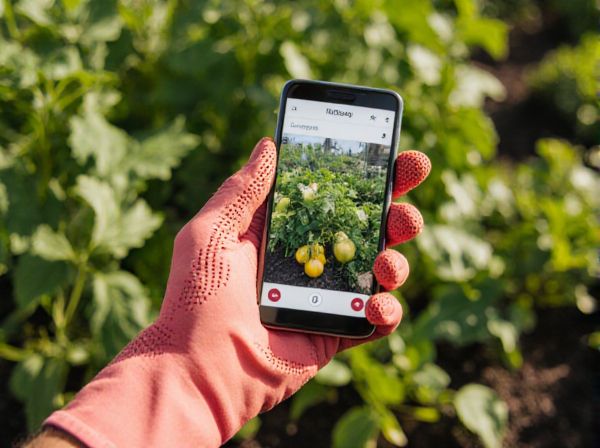
Heirloom varieties vs Cultivar hybrids Illustration
Heirloom varieties offer unique flavors and historical significance, preserved through generations with seeds saved by gardeners, making them highly valued for their authenticity and adaptability. Cultivar hybrids are bred for specific traits like disease resistance and uniformity, ensuring consistent performance and higher yields in modern gardening. Choosing between heirlooms and hybrids depends on whether the priority is conserving genetic heritage or maximizing productivity and reliability.
Table of Comparison
| Feature | Heirloom Varieties | Cultivar Hybrids |
|---|---|---|
| Genetic Origin | Open-pollinated, stable genetics | Crossbred, hybrid vigor |
| Flavor & Aroma | Rich, diverse flavors | Consistent, often milder |
| Appearance | Unique, varied shapes and colors | Uniform, standardized |
| Growth Habit | Adapted to local conditions | Optimized for yield and disease resistance |
| Seed Saving | Viable for replanting | Not reliable; seeds often sterile |
| Longevity | Heirloom plants persist over generations | Requires annual purchase of seeds or plants |
| Use in Ornamental Gardening | Preferred for unique aesthetic and heritage value | Chosen for uniformity and controlled growth |
Understanding Heirloom Varieties in Ornamental Gardening
Heirloom varieties in ornamental gardening represent traditional plants cultivated for generations, valued for their natural genetics and unique aesthetic traits that contribute to biodiversity. These plants often exhibit superior adaptability, resilience, and distinctive flower forms compared to cultivar hybrids, which are selectively bred for uniformity, color, and disease resistance. Emphasizing heirloom varieties supports the preservation of genetic heritage and promotes ecological balance within ornamental landscapes.
What Defines a Cultivar Hybrid Ornamentals?
Cultivar hybrid ornamentals are specifically bred plants resulting from the controlled cross-pollination of two distinct parent varieties to combine desirable traits such as vibrant colors, disease resistance, and improved growth habits. Unlike heirloom varieties, which are open-pollinated and stable over generations, cultivar hybrids often exhibit hybrid vigor but do not reliably reproduce true-to-type from seed. These hybrids are essential in landscaping and gardening for their enhanced ornamental appeal and adaptability to various environmental conditions.
Key Differences Between Heirloom and Hybrid Ornamentals
Heirloom ornamentals are open-pollinated plants that preserve historical genetics and offer unique, stable traits passed down through generations, whereas cultivar hybrids result from controlled crosses to enhance specific characteristics such as color, disease resistance, or bloom time. Heirloom varieties emphasize genetic diversity and resilience, often adapting well to local conditions, while hybrid ornamentals prioritize uniformity and performance, providing reliable aesthetics for landscapes and gardens. The choice between heirloom and hybrid ornamentals depends on goals like preserving biodiversity or achieving consistent ornamental quality.
The Historical Significance of Heirloom Ornamentals
Heirloom ornamental plants carry a rich historical significance, having been preserved and passed down through generations for their unique aesthetic qualities and resilience. These varieties often reflect the cultural heritage and gardening traditions of specific regions, showcasing genetic diversity lost in modern cultivar hybrids. Cultivar hybrids, while bred for uniformity and enhanced traits, lack the deep-rooted historical narratives that heirloom ornamentals embody.
Advantages of Cultivar Hybrids for Gardeners
Cultivar hybrids offer gardeners enhanced disease resistance, increased vigor, and uniformity in growth, ensuring consistent and reliable flowering or fruiting. These hybrids are bred for improved adaptability to diverse environmental conditions, making them ideal for various garden settings. Their predictable traits allow for easier maintenance and more impressive ornamental displays compared to traditional heirloom varieties.
Preserving Genetic Diversity in Ornamental Gardens
Heirloom varieties in ornamental gardens preserve genetic diversity by maintaining original plant traits passed down through generations, offering unique colors, shapes, and resilience adapted to specific environments. Cultivar hybrids provide uniformity and disease resistance but often limit genetic variation, potentially reducing long-term adaptability to changing conditions. Emphasizing heirloom preservation supports biodiversity and ecosystem health within ornamental horticulture by safeguarding rare and diverse genetic pools.
Disease Resistance: Heirloom vs. Hybrid Ornamentals
Heirloom ornamental varieties often exhibit unique genetic traits but typically have lower disease resistance compared to cultivar hybrids, which are selectively bred for enhanced resilience against common pathogens. Cultivar hybrids benefit from modern breeding techniques that incorporate disease-resistant genes, leading to longer-lasting and healthier plants in ornamental gardens. Choosing hybrids can significantly reduce the reliance on chemical treatments, promoting sustainable and vibrant landscape designs.
Aesthetic Appeal: Traditional vs. Modern Ornamental Plants
Heirloom varieties in ornamental plants showcase rich, traditional aesthetic appeal with unique, time-tested colors and forms that evoke nostalgia and classic garden charm. Cultivar hybrids offer modern ornamental plants featuring enhanced vibrancy, novel shapes, and extended blooming periods that cater to contemporary landscaping trends. The contrast between heirloom and hybrid aesthetics reflects evolving preferences from heritage elegance to innovative design versatility.
Sourcing and Growing Heirloom Ornamentals
Heirloom ornamentals, treasured for their historical genetic purity, require sourcing from specialized nurseries and seed banks that preserve their unique traits. Growing heirloom varieties demands careful attention to soil conditions and traditional cultivation methods to maintain their authenticity and resilience. Unlike cultivar hybrids, heirlooms often exhibit greater adaptability and genetic diversity, making them valuable for sustainable garden ecosystems.
Choosing the Right Variety: Factors for Ornamental Gardeners
Heirloom varieties offer unique genetic diversity and historical charm, attracting gardeners seeking authentic, time-tested blooms with rich coloration and fragrance. Cultivar hybrids provide enhanced disease resistance, uniform growth habits, and extended blooming periods, ideal for low-maintenance, high-performance ornamental gardens. Evaluating soil conditions, climate adaptability, and maintenance preferences is crucial for selecting the right variety to maximize aesthetic appeal and garden longevity.
Heirloom varieties vs Cultivar hybrids Infographic

 gardendif.com
gardendif.com